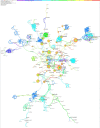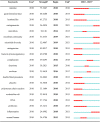Emerging trends and focus of human gastrointestinal microbiome research from 2010-2021: a visualized study
- PMID: 34332587
- PMCID: PMC8325541
- DOI: 10.1186/s12967-021-03009-8
Emerging trends and focus of human gastrointestinal microbiome research from 2010-2021: a visualized study
Abstract
Background: The gastrointestinal microbiome is an important component of the human body and is closely related to human health and disease. This study describes the hotspots of the human gastrointestinal microbiome research and its evolution in the past decade, evaluates the scientific cooperation network, and finally predicts the field's future development trend using bibliometric analysis and a visualized study.
Methods: We searched the original articles from January 2010 to February 2021 in the Scopus database using the term "gastrointestinal microbiome" and its synonyms. CiteSpace was used to construct country and author co-occurrence map; conduct journal, citation cocitation analysis, and reference co-citation knowledge map; and form a keywords co-occurrence map, a clustering knowledge map, timeline view of keywords, and burst term map.
Result: A total of 4444 documents published from January 2010 to February 2021 were analysed. In approximately the past decade, the number of articles on the human gastrointestinal microbiome has increased rapidly, and the research topics focus on different populations, research methods, and detection methods. All countries and regions in the world, led by the US, are studying the human gastrointestinal microbiome, and many research teams with close cooperation have been formed. The research has been published extensively in microbiology journals and clinical medicine journals, and the highly cited articles mainly describe the relationship between gastrointestinal microorganisms and human health and disease. Regarding the research emphasis, researchers' exploration of the human gastrointestinal microbiome (2011-2013) was at a relatively macro and superficial stage and sought to determine how the gastrointestinal microbiome relates to humans. From 2014 to 2017, increasingly more studies were conducted to determine the interaction between human gastrointestinal flora and various organs and systems. In addition, researchers (2018-2021) focused on the gastrointestinal microbial community and the diversity of certain types of microbes.
Conclusion: Over time, the scope of the research on the clinical uses of the gastrointestinal microbiome gradually increased, and the contents were gradually deepened and developed towards a more precise level. The study of the human gastrointestinal microbiome is an ongoing research hotspot and contributes to human health.
Keywords: Bibliometric; Emerging trends; Gastrointestinal microbiome; Human; Research focus; Scopus; Visualized study.
© 2021. The Author(s).
Conflict of interest statement
We declare that all authors have no competing interests.
Figures









Similar articles
-
Emerging trends and research foci in gastrointestinal microbiome.J Transl Med. 2019 Feb 28;17(1):67. doi: 10.1186/s12967-019-1810-x. J Transl Med. 2019. PMID: 30819194 Free PMC article.
-
Advances in gut microbiome in metabonomics perspective: based on bibliometrics methods and visualization analysis.Front Cell Infect Microbiol. 2023 May 30;13:1196967. doi: 10.3389/fcimb.2023.1196967. eCollection 2023. Front Cell Infect Microbiol. 2023. PMID: 37325519 Free PMC article.
-
Emerging trends and focus for the link between the gastrointestinal microbiome and kidney disease.Front Cell Infect Microbiol. 2022 Aug 15;12:946138. doi: 10.3389/fcimb.2022.946138. eCollection 2022. Front Cell Infect Microbiol. 2022. PMID: 36046740 Free PMC article.
-
Global research trends in regulating gut microbiome to improve type 2 diabetes mellitus: bibliometrics and visual analysis.Front Endocrinol (Lausanne). 2024 Jun 3;15:1401070. doi: 10.3389/fendo.2024.1401070. eCollection 2024. Front Endocrinol (Lausanne). 2024. PMID: 38887274 Free PMC article. Review.
-
Nexus Between Sarcopenia and Microbiome Research: A Bibliometric Exploration.J Multidiscip Healthc. 2024 Jun 24;17:3011-3025. doi: 10.2147/JMDH.S469747. eCollection 2024. J Multidiscip Healthc. 2024. PMID: 38948393 Free PMC article. Review.
Cited by
-
Research progress and hotspot analysis of rhizosphere microorganisms based on bibliometrics from 2012 to 2021.Front Microbiol. 2023 Feb 23;14:1085387. doi: 10.3389/fmicb.2023.1085387. eCollection 2023. Front Microbiol. 2023. PMID: 36910227 Free PMC article. Review.
-
Mapping knowledge structure and themes trends of non-surgical treatment in intervertebral disc degeneration.Heliyon. 2024 Aug 28;10(17):e36509. doi: 10.1016/j.heliyon.2024.e36509. eCollection 2024 Sep 15. Heliyon. 2024. PMID: 39286189 Free PMC article. Review.
-
Gut microbiota and autism spectrum disorders: where do we stand?Gut Pathog. 2023 Oct 25;15(1):50. doi: 10.1186/s13099-023-00575-8. Gut Pathog. 2023. PMID: 37880713 Free PMC article.
-
An examination of global research trends for exploring the associations between the gut microbiota and nonalcoholic fatty liver disease through bibliometric and visualization analysis.Gut Pathog. 2024 Jul 3;16(1):31. doi: 10.1186/s13099-024-00624-w. Gut Pathog. 2024. PMID: 38961453 Free PMC article.
-
Developmental trends and knowledge frameworks in the application of radiomics in prostate cancer: a bibliometric analysis from 2000 to 2024.Discov Oncol. 2024 Dec 18;15(1):781. doi: 10.1007/s12672-024-01678-7. Discov Oncol. 2024. PMID: 39692833 Free PMC article.
References
-
- Li M, Gao J, Tang Y, Liu M, Wu S, Qu K, Long X, Li H, Liu M, Liu Y, et al. Traditional herbal medicine-derived sulforaphene LFS-01 reverses colitis in mice by selectively altering the gut microbiota and promoting intestinal gamma–delta T cells. Front Pharmacol. 2017;8:959. doi: 10.3389/fphar.2017.00959. - DOI - PMC - PubMed
Publication types
MeSH terms
LinkOut - more resources
Full Text Sources
Miscellaneous

